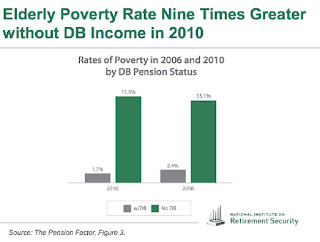Pension
Income in 2010 Resulted in Public Assistance Savings of $7.9 Billion, 4.7
Million Fewer Households in Poverty or Near-Poverty
 WASHINGTON,
D.C., July 26, 2012 -
Rates of poverty among older households lacking defined benefit (DB) pension
income were approximately nine times greater than the rates among older
households with DB pension income in 2010, up from six times greater in
2006 a new study calculates. Older households with lifetime pension
income are far less likely to experience food, shelter, and health care
hardship, and less reliant on public assistance. The data also indicate that
pensions are a factor in preventing middle class Americans from slipping into
poverty during retirement.
WASHINGTON,
D.C., July 26, 2012 -
Rates of poverty among older households lacking defined benefit (DB) pension
income were approximately nine times greater than the rates among older
households with DB pension income in 2010, up from six times greater in
2006 a new study calculates. Older households with lifetime pension
income are far less likely to experience food, shelter, and health care
hardship, and less reliant on public assistance. The data also indicate that
pensions are a factor in preventing middle class Americans from slipping into
poverty during retirement.
Download the full report
and supporting PowerPoint here.
Oakley continued, "Now,
we're now staring at a future with older Americans - many of them middle class
- who may be unable to pay their basic bills and at risk of falling into
poverty. There is a steep price to pay when older Americans can no longer be
self-sufficient in retirement - either as increased public assistance costs to
taxpayers or backsliding to a time with elder Americans living in
poverty."
Report co-author Dr. Frank Porell said,
"The analysis indicates pensions exert an independent, positive impact on
older Americans' economic well-being - an effect we call the 'pension
factor.' This 'pension factor' is particularly strong for more vulnerable
subpopulations of elder households. In fact, gender and racial disparities in
poverty rates, material hardships, and public assistance rates are greatly
diminished, and in some cases nearly disappear, among households receiving
pension income. The bottom line is that households with a pension fare better
than those without - even after controlling for socio-demographic factors such
as education, race, gender, and work history," said Porell.
Porell added, "In
2010, governments spent about $7.9 billion dollars less on public assistance to
older households because of pension income. This represents about 6.4 percent
of aggregate public assistance dollars received by all American households from
similar benefit programs. These are substantial dollars, particularly in light
of the growing financial pressure on government programs in the wake of the
financial crisis."
More specifically, the report
estimates that in 2010, DB pension receipt among older American households was
associated with:
- 4.7 million fewer poor and
near-poor households.
- 460,000 fewer households that
experienced a food insecurity hardship.
- 500,000 fewer households that
experienced a shelter.
- 510,000 fewer households that
experienced a health care.
- 1.22 million fewer households
receiving means-tested public assistance.
More broadly, the study also
finds:
- a continued decrease in rates
of DB pension income receipt likely related to more than three decades of
declining DB plan participation rates among active employees.
- increasing numbers of older
American workers will be entering retirement without the security of a
pension.
- older households with pension income
generally fared better during the recent economic turmoil relative to
households without such income.
- income from pensions may be
especially important to middle income American households.
- lower rates of DB pension
receipt are found among older persons living in the West and South
relative to other regions.
- pensions have helped many older
minority and female-headed households escape poverty.
The analysis was conducted
using the U.S. Census Bureau's Survey of Income Program Participation (SIPP)
panels. The study sample included SIPP respondents age 60 years or older and
all households with a head age 60 and older, who had records in both the
Pension and Adult Well-Being topical modules of the survey.
Additional data and analysis is
available in the full research brief available at www.nirsonline.org.
The
National Institute on Retirement Security is a non-profit organization established to
contribute to informed policymaking by fostering a deep understanding of the
value of retirement security to employees, employers, and the economy through
national research and education programs. Located in Washington, D.C., NIRS has
a diverse membership of organizations interested in retirement including
financial services firms, employee benefit plans, trade associations, and other
retirement service providers.
Contact:
Kelly Kenneally
202.457.8190 o
202.256.1445 m
kkenneally at
nirsonline.org



No comments:
Post a Comment